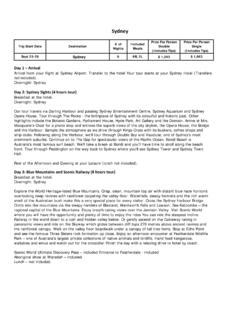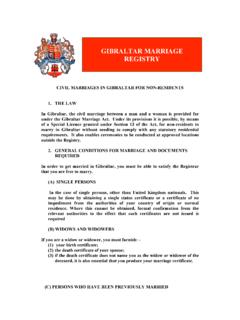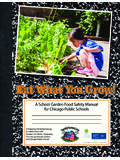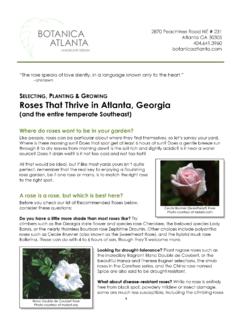Transcription of A Guide for Gardeners in Queensland Sub Tropics …
1 The Nursery Industry -Protecting Our EnvironmentA Guide for Gardeners in Queensland Sub TropicsSUBTROPICS2 Cover photo courtesy of Barry Naylor1) ContentsContentsAcknowledgementsIntroduc tion from the MinistersIntroductionWhat is Grow Me Instead?Establishing the criteria for Grow Me InsteadWhat you can do!Controlling weedsThe invasive plants and their alternativesTrees and ShrubsClimbing and Ground Cover PlantsBerried PlantsGrassesBulbous PlantsSucculent PlantsAquatic PlantsInvasive plant indexFurther information and additional resources The Grow Me Instead (GMI) project was first initiated by the Nursery and Garden Industry of NSW & ACT (NGINA) as a voluntary partnership with its member nurseries to encourage the removal from production and sale of plants known to be invasive in the natural environment. This Queensland Sub- Tropics Bioregion Grow Me Instead booklet has been produced by NGIQ through funding from the Australian Government s Caring for our Country.
2 Australian Government NRM Team GPO Box 787 Canberra ACT 2601 Australia Ph 1 800 552008 (Toll Free) Web Special thanks go to Grow Me Instead project coordinator Barry Naylor (NGIQ) and project manager John McDonald (Nursery Industry Development Manager NGIQ). The Nursery and Garden Industry Queensland would like to acknowledge the people who generously contributed their time and expertise and who provided a wealth of information towards the production of this booklet. Special thanks go to the members of the four regional Grow Me Instead Committees in Brisbane, Gold Coast, Sunshine Coast and Bundaberg/Wide Bay that contributed to the Sub- Tropics GMI Booklet:Nora BrandliBurnett Mary Regional GroupMaree BretzEden Gardens and Garden CentrePeter BrownWide Bay Institute of TAFEP hilip CameronBrisbane Botanic GardensAlison ChapmanSEQ CatchmentsDorean ErhartBrisbane City CouncilBill FlenadySunshine Coast Regional CouncilJen FordGold Coast City CouncilTrevor FranklinAustralian Plant NurseriesHellen HaapakoskiBiosecurity QueenslandMartin Hannan-JonesBiosecurity QueenslandSteven HartNGIQKate HeffernanConsultantAilsa HollandQueensland HerbariumAlex JakimoffAlexander s NurseryPaul LancasterSuncoast Water Gardens Pty LtdMartin LeitchLogan City CouncilAnthony LewisAdvanced PropagationRachel McFadyenWeed Society of QueenslandRoss McKinnonBrisbane Botanic GardensLex McMullenNGIQB rett MockeLifestyle Home and GardenSheldon NavieUniversity of QueenslandCarol NewmanAitken & Newman TubegrowersTracey O ConnellSunshine Coast Regional CouncilRobert PercyAspley NurseryGlenda PitmanWide Bay Institute of TAFEJohn
3 PrinceDeep Rainforest Co Australia Pty LtdTim RichBundaberg Regional CouncilDavid RobertsBrisbane North Institute of TAFEM aureen SchmittBundaberg & District Urban LandcareSpencer ShawBrush Turkey EnterprisesKathy StephensQueensland HerbariumChris TrudgianElsewhere NurseryNick Walford SmithConsultant The Nursery & Garden Industry Australia through it s National GMI Committee Delwyn Thomas (Project Manager), Robert Prince (Chief Executive Officer NGIA), Anthony Kachenko (National Environmental and Technical Policy Manager) and Robert Chin (NGIV). The Blue Mountains City Council for providing the section on controlling weeds. For further information and additional resources please contact (02) 4780 5000. The many people and organisations who contributed photographs used in this ) Acknowledgements4 The nursery and gardening industry has joined with the Australian Government in the fight against invasive garden plants. In championing this initiative, Nursery and Gardening Industry Australia (NGIA) is taking a significant step forward in tackling one of the nation s most serious environmental problems the spread of Grow Me Instead campaign is a great industry-driven initiative providing relevant local information to nursery operators and Gardeners about plants which are potential weeds in their area and less invasive plants for Gardeners to cooperation between the horticulture and nursery industries, the Australian Government and weed management bodies will help ensure horticulturalists and Gardeners receive the information they need to combat the spread of is estimated that weeds cost the Australian agricultural industry around $4 billion a year.
4 The real cost of weeds to the environment is difficult to calculate, however it is likely to be at least equal to the cost to agriculture. Of the almost 3000 introduced plant species now known to be established in the Australian environment, 65% are escaped garden plants. An important step in preventing the spread of weeds is public education to help change attitudes and behaviours that contribute to the weed Government is committed to investing in initiatives that have real on-ground benefits for the environment and for industry. We commend this initiative to ) Introduction from the Ministers The Hon Peter Garrett AM MPMinister for the Environment, Water, Heritage and the Arts The Hon Tony Burke MP Minister for Agriculture, Fisheries and Forestry54) IntroductionThe Nursery and Garden Industry in Australia employs about 45,000 people in some 22,000 businesses across the country. For many years the Industry has been conscious of their environmental responsibilities and they have been proactive in furthering educational programs, including those concerning invasive garden plants.
5 Garden escapes are not a new issue: weeds have been around since the first settlers brought along reminders of home to help them settle into a new and strange land. How strange the Australian landscape must have seemed then, and how natural it would have been for the settlers to want only the tried and true familiar garden plants of the British Isles. Despite the difficulties of creating a garden in the Antipodes, it took many years for the average Australian to appreciate the native flora of this great , there were the early acclimatisation societies who thought it a good idea to introduce plants and animals from the old country and also to spread Australian native plants from state to state. Although great damage to the environment has occurred as a result of these indiscriminate introductions, this has not been solely the fault of the horticultural industry: certainly other industries have contributed. Graziers have imported new grasses and fodder crops and there were accidental imports that came about unwittingly through inappropriate packaging, movement of plant and machinery, as seed in fodder and in ships , the weed issue and who is actually responsible should not become a blame game.
6 Together we must seek to repair what damage we can and to work together as a community to prevent similar damage occurring in the Nursery & Garden Industry is actively participating in lessening the availability of invasive plants in Australia by preventing their production and sale. The Industry has recently established a greater understanding and cooperation with both State and Federal Governments, culminating in this important Grow Me Instead booklet. Greater awareness and education of the home gardener is a major part of the answer to this problem. By using the information in the Grow Me Instead booklet as a Guide and consulting with your local garden centre or plant nursery, you can help to minimise garden escapes and create a better environmental future for following generations of ) What is Grow Me Instead? The original Grow Me Instead booklet developed by the Nursery & Garden Industry NSW & ACT (NGINA) has now been extended as a national program by the Nursery & Garden Industry Australia (NGIA), in partnership with the Federal Government, to reduce the numbers and impact of invasive plants in Australia.
7 An environmentally invasive plant is just another term for a weed. Quite simply, a weed is any plant that poses a threat to the environment, adversely impacts human or animal health, or causes crop or stock losses. For most Gardeners , many of the characteristics we most desire in garden plants are the same as those that make them weedy: plants that are fast growing and disease resilient and those which reproduce easily by the distribution of seeds or plant parts. A modern definition of a weed is a plant that requires some form of action to reduce its effect on the economy, the environment, human health and amenity . Many of the plants that are now considered to be environmental weeds were introduced by early settlers, or by Gardeners and farmers who had little or no knowledge of their future impact on the native environment. It is only in recent years that this threat has become is not confined to introductions from overseas. Some Australian native plants introduced from other regions may impact adversely on the natural environment.
8 Non-indigenous ( not local) species may invade and displace species natural to that area or they may cross pollinate to produce new species which may in time alter regional biodiversity. Cootamundra Wattle (Acacia baileyana) is a good example of the former, while many eucalypts are known to species may sometimes be controlled in a foreign climate by various vectors such as small animals, insects, diseases or climatic conditions such as frost, thus reducing potential Gardeners , farmers or botanists, the term weed may mean different things. Pasture weeds reduce the productivity of agricultural land and may also have negative effects on human and animal health. Environmental weeds cause various problems in natural areas and ecosystems and the cost of control for both farmers and government is estimated at billions of dollars per and more effective management of invasive plants will help to reduce the high cost of chemical control, and to reduce the amount of time and energy lost in management of weeds in productive land for food crops, grazing land, cut flowers and forestry.
9 Weed management in public spaces and on natural heritage land is costly, laborious and at times seems is important to reduce the spread of environmental weeds Noxious weeds - are those legally declared as noxious plants by the various State or Territory Governments. The declaration of noxious weeds will vary from state to state and from region to region within a state. In general, most state legislation will say that declared noxious plants cannot be grown, sold or transported or transposed, and removal is required. 2. Weeds of National Significance ( WoNS ) - are some of the most significant weeds in Australia. All WoNS have been declared illegal for sale in each state of Environmental weeds - plants that are or have the potential to impact the natural environment by destroying habitat or over-running indigenous species and altering local biodiversity. Many of our worst environmental weeds are garden Agricultural & Horticultural weeds - are those plants that have a negative effect on crop or animal production.
10 This may be through the infiltration of weed seed in grain crops, burrs in wool production or weeds which make animals sick or cause death. In the horticultural industry, weeds within cut flower, fruit and vegetable crops can harbour pests and diseases which reduce plants are defined and grouped as follows. is to identify common garden plants that have now become environmental weeds in your local area, and to suggest better, alternative plants that benefit garden diversity while lessening their potential to become weeds of the future. Apart from nurseries, garden centres or the resources of the local botanic gardens, valuable information may be provided by the Natural Resource Management Boards or you may wish to check out their websites. Here you will find lists of declared weeds for the local area and contact details should you need further information regarding invasive plant identification and approved methods of disposal. The purpose of this Grow Me Instead ) Establishing the criteria for Grow Me Instead It has been very important to establish a set of consistent criteria which could be adhered to across all regions and ) The Invasive PlantsThe Nursery & Garden Industry Queensland , in consultation with its members, State and Local Governments and a wide range of interested stakeholders has developed a list of 30 invasive garden plants.







